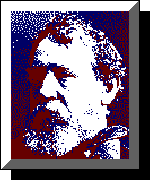Mosaical Metrology
· 3D Decalogue
· 2D Alphabet ·
Kabbalah · Pyramid Builders · Israelite Dynasty · Western Philosophy ·
Musical Theory ·
Metzler Formula · Mosaical Religions
The City of David or Thebes in Egypt is where Queen
Hatshepsut-Sheba lived, till her husband King Solomon-Thutmosis II
“had made an end of building his own
house, and the house of YaHUH, and the wall
of Jerusalem round about” (1. Kings 3, 1). After him it is named the City
“Ir” of Solomon, cf. Ed Metzler, Conflict of Laws in the Israelite
Dynasty of Egypt (Herborn 1991), pp. 13, 30.
| | Without the city wall built by King
Solomon, without his palaces, and without the temple – Jerusalem was no city at
all, but a village at best! Therefore, it rightly bears the name of its founder and builder King
Solomon: Jeru- [= ‘Ir “City” of] Salem =
Salomo (Hebrew Shelomoh), whence Yeru-Shalayim.
Of course,
Jerusalem is mentioned on the Amarna tablets as Urusalim, which only goes to prove
that they are about 100 years after King Solomon, towards the end of the Israelite (18th)
dynasty of Egypt. Another name is ‘Ir ha-Kodesh (Arabic El-Kuds), the
Holy City for its Holy of Holies in the
Temple of King Solomon-Thutmosis II,
– mentioned at the beginning of the Israel list of his son Thutmosis III.
|
By mistake, the City of David is commonly placed in
the immediate vicinity of the Temple Mount in
Jerusalem, only a few hundred yards southeast. This is absurd because, while under
construction by a work-force of 183 300 (1. Kings 5, 27-30), Jerusalem really was no place for
a princess to live, see Ed Metzler, Conflict of Laws in the Israelite
Dynasty of Egypt (Herborn 1991), p. 13 N. 19.
King David-Thutmosis I was buried in the City of David, which is the Valley of the
Kings near Thebes in Egypt. This is proven by the fact that the tradition of burying the Kings
of Jerusalem there, continued for over 200 years, and was interrupted only by the Assyrian
conquest of Israel and Egypt. cf. Ed Metzler, Conflict of Laws in the Israelite
Dynasty of Egypt (Herborn 1991), p. 12 N. 17. Even the
name of David, which is spelled DUD or DOD in Hebrew, is identical with
Thutmosis, Tuthmosis or Thothmes, and its hieroglyphic
transliteration yields Thebes (see above). Its Egyptian name is Wus in Jebus, and
Zion derives from Diospolis, the city of Zeus, genitive Dios, cf.
Ed Metzler, Conflict of Laws in the Israelite
Dynasty of Egypt (Herborn 1991), pp. 13-14 Notes 18 and 20.

Thus, the Israelite (18th) dynasty of Egypt was
trilingual, Greek being due to the Mycenaean Cretans, who played an important role at the
court of King David-Thutmosis I (1. Kings 1, 38-44). The Psalms and the Song of Songs were translated, and
Israel’s monotheism had its impact on Egypt, cf. Ed Metzler, Conflict
of Laws in the Israelite
Dynasty of Egypt (Herborn 1991), pp. 14, 31.
Visit Shilo, Moziani's
Jewish Heritage Site,

Israel’s First Capital,
and I hope the
Next!
I’d love to teach Mosaistics at a university, preferably, of course, within the Law
School or Faculty of Law; just email me to Moziani@gmail.com.
See my books in the catalogue of The
National Library of Israel and the Hebrew University Library in Jerusalem, Israel, and in the official German Books in Print (VLB 1996-98) of the German Booksellers’ Association.
|
![]() stands for the Promised Land
of Israel,
stands for the Promised Land
of Israel,